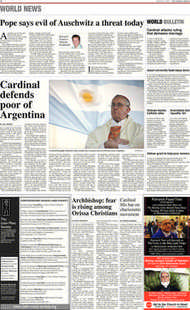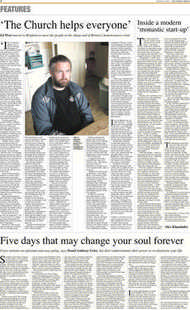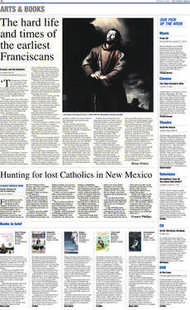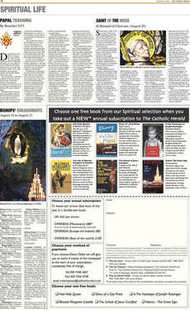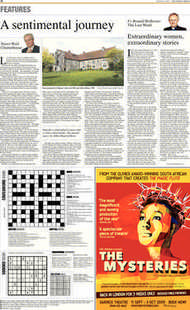Page 9, 14th August 2009
Page 9
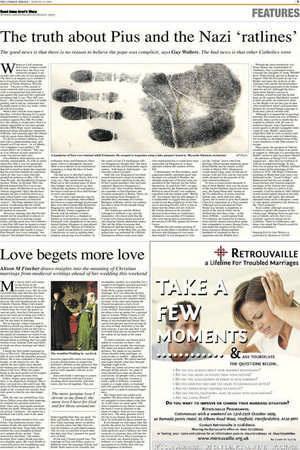
Report an error
Noticed an error on this page?If you've noticed an error in this article please click here to report it.
Tags
Share
Related articles
Secret Papers Vindicate Pope Pius Xii, Says Jewish Scholar
Pius Xii And The Nazi Persecutions
Fr. Robert A. Graham, S.j., Looks At Saul Friedlander's...
Defence Of Pius Xli's Attitude To Nazis
Pius Xii, War And The Jews
The truth about Pius and the Nazi ‘ratlines ’
Whenever I tell someone that I have written a book about how the Nazi war criminals escaped, I am usually met with one of two reactions. The first is an enquiry as to whether I have found any Nazis hiding in the jungles of South America. (For the record – I haven’t.) The second is more common and is accompanied with a conspiratorial lean forward, a tap against the nose and the supposed revelation that it was “Pius XII, you know”. My normal reaction is to smile politely and to tell my informant that he really needs to buy my book, where all will be revealed.
What I don’t tell the nose-tapper is that they will find Hunting Evil a great disappointment, as there is simply no evidence against Pius XII. Nevertheless, the charge is so pervasive that it is almost impossible to convince people that the 260th Pope wasn’t running a personal ratline through the catacombs of Rome, and cracking open the Chianti with his good chum Adolf Eichmann.
If I do try to mount a defence, I am met with a condescending look, and treated as if I am naïve – or a Catholic. (As it happens, I am neither.) “Of course there’s no evidence,” they say, as if an absence of such material in some way proves their case.
Nevertheless, their theories are not entirely unreasonable. As with so much about Pius XII, it was his seemingly ambiguous attitude towards fascism that did so much to foster the suspicion that he must have helped its exponents. After all, this was a man who had granted an audience in May 1941 to Ante Pavelić, the bloodthirsty Croatian dictator. When, in October 1942, the British learned that Pius was to see Pavelić again, the British envoy to the Vatican suggested “that I should have thought the line would be drawn at a man whose hands were dripping with the blood of thousands of innocent victims”. The Pope relented, but such actions would mean that he would forever be tainted by those with whom he desired to associate.
However, meeting men like Pavelić should not be considered evidence of papal complicity in running escape routes, and the good news for Catholics is that Pius XII must be treated as innocent. Sometimes my interlocutor is big enough to admit that maybe it wasn’t Pius himself, but it was certainly “the Vatican” that helped Nazis on their way to Buenos Aires and Damascus. Once again, I have to disappoint, because there is no evidence of an institutional conspiracy to help the likes of Josef Mengele.
The bad news is that the Catholic priests who did help the Nazis, did so in a big way. They turned more than a blind eye to the criminal pasts of those they helped, and it is fair to say that without the assistance of such priests, the Nazis could never have fled Europe in such vast numbers.
The two most vital priestly cogs in the system of machinery that enabled the Nazis to escape through Austria and Italy were the Croatian Mgr Krunoslav Draganović and the Austrian Bishop Alois Hudal. A keen supporter of Pavelić and his barbaric Ustashi, Draganović served as a chaplain at Jasenovac concentration camps, where thousands were slaughtered in the most bestial fashion. Draganović also played a key role in the “Bureau of Colonisation” which forced Serbs to convert to Catholicism, as well as stealing their property and giving it to Croatians. In the words of one US intelligence officer, Draganović thought that “the ideas espoused by this arch-nationalist organisation – half-logical, half-lunatic – are basically sound concepts”.
After the war, Draganović travelled around internment camps in northern Italy and Austria checking on the fate of the Ustashi members who had been captured. However, Draganović’s “relief work” also involved sheltering his comrades at San Girolamo, the Croatian monastery in Rome, There, on the mezzanine floor, Draganović founded the Committee of Croatian Refugees in Rome, which was nothing less than a front for his people-smuggling activity.
The Americans and the British managed to infiltrate a spy into the monastery, who discovered that the Ustashi were being ferried around in cars bearing Vatican diplomatic plates. This led the Allies to assume that Draganović had the backing “at the highest level” of the Holy See, an allegation that was reiterated by a British intelligence officer some years later, who maintained that it would have been impossible for Draganović to have operated without the consent of Pius XII.
Unfortunately for Pius-bashers, such suspicions hardly constitute proof that the pope was complicit. Besides, the ultimate protectors of Pavelić were not members of the Vatican, but the Allies themselves. In mid-July 1947, an operation mooted by the Americans and the British to arrest Pavelić was suddenly cancelled with the simple order “Hands off”, for reasons that are still opaque. It is fashionable to suggest that an arrest would reveal the complicity of the Vatican in assisting Pavelić, but it is just as likely that the Allies did not wish for the former dictator to be arrested because to have done so would have alienated a vast number of Croatians who were being used as informers in the nascent Cold War against the Soviet Union.
Whether Pavelić ended up being of any use to the Allies is doubtful, but we do know that Draganović was more than helpful. It was Draganović who ran the “ratline” down which the Gestapo officer-turned-American agent Klaus Barbie and his family would scuttle in March 1951. Draganović would spend many years in and out of contact with the CIA, and he was eventually dropped on the grounds of his utter untrustworthiness.
No less a controversial character is that of Alois Hudal, who was the rector of the Austro-German church and seminary, the Santa Maria dell’Anima on the Via della Pace. It is this Austrian bishop who, more than any other figure, did so much to give the Catholic Church its reputation as a Nazi conduit. Although not an out-and-out Nazi, Hudal was broadly sympathetic to much of the fascist creed, but he disliked the idea that a man – in the form of Hitler – could replace God. Nevertheless, his hatred for Communism and his intense nationalism made him sympathetic to many fleeing Nazis, and under the auspices of his Assistenza Austriaca, Hudal enabled hundreds of criminals to flee to Argentina and the Middle East. Perhaps the most murderous was Franz Stangl, the commandant of Treblinka, who is estimated to have overseen the slaughter of some 780,000 Jews. When Stangl arrived in Rome in August 1948, his first port of call was Hudal, and today the archives of the seminary still contain the handwritten CV that Stangl presented to the bishop upon his arrival. Although the document omits Stangl’s service at Treblinka, it does reveal that he had been an SS captain. Had Hudal wanted to find out more, he could have done so, but Hudal was not the type of man who would have asked such questions. Instead, he secured Stangl a passage to Syria and a job at a textile mill.
Although it is impossible to ascertain precisely the extent and size of Hudal’s network, there can be no doubt that he worked in cahoots with all sorts of nefarious figures, from Argentinian secret agents to people-smugglers motivated by cash. Hudal’s motivation might have had its roots in charity and converting more souls to Catholicism, but in doing so, he helped some of the worst murderers of the 20th century to escape.
Once again, the question of Vatican complicity arises, but there is no proof to support it. Although it is possible that Hudal’s archives may have been filleted – the presence of Stangl’s CV would suggest not – they bear no evidence of Vatican or papal knowledge. In fact, Pius was no great fan of Hudal, and had even removed his patronage of the Anima in 1939. The Pope’s Christmas greetings to Hudal that year were even addressed to the “Aryan College”, and Hudal found that he was unable to bring German and Austrian pilgrims into parts of the Vatican that would normally be open to a priest of his seniority. Until his death in 1963, Hudal would remain openly proud of the help he had given the Nazis. His attitude alienated many of his colleagues, some of who openly referred to the Anima as the “Nazi seminary”.
Such a label, although somewhat extreme, captures the essence of the whole issue. Helping Nazis escape was not a Catholic activity, but it was certainly a pursuit carried out by Catholics. There is a difference, and those who attack the Church would do well to remember it.
Hunting Evil by Guy Walters is published by Bantam at £18.99
blog comments powered by Disqus





